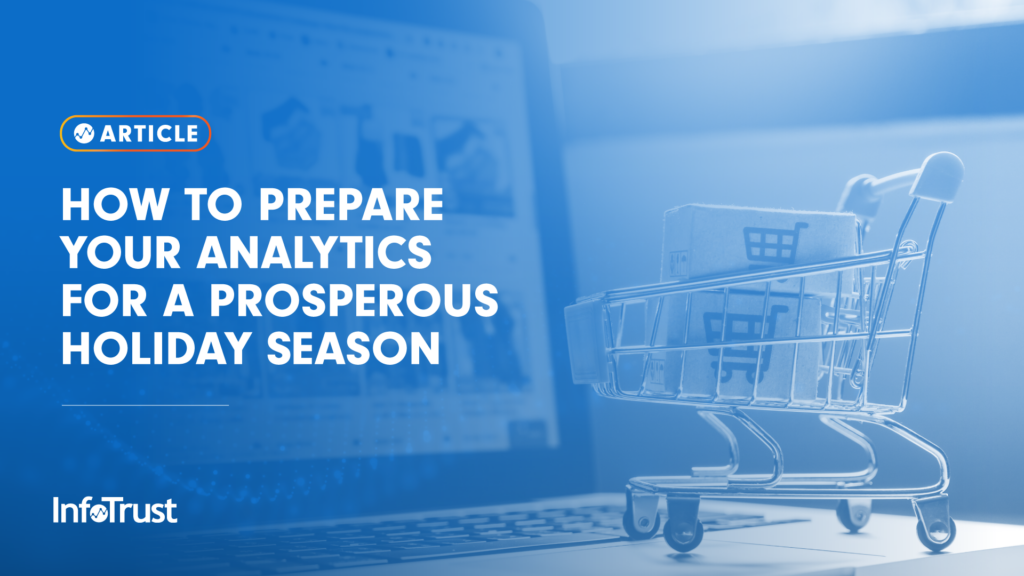For retailers, the holiday season is make-or-break. This time of year can account for a significant portion of annual sales, so it’s crucial that marketing campaigns are carefully planned for and well executed. Retailers need to be able to show not only that their campaigns are effective, but also that they are providing value for the business. This is where analytics come in. By tracking key metrics, retailers can gain insights into which campaigns are most successful and adjust their strategy accordingly. With the right data, retailers can ensure that their holiday season is prosperous and stress-free.
At InfoTrust, our most sophisticated partners are focused on driving the best return on advertising spend (ROAS) for their campaigns. With a little preparation, you can make sure your analytics are ready for the influx of holiday traffic. By tailoring your strategies to multiple segments of your customer base, you can provide the flexibility to adjust in real-time. This approach allows our partners to maximize their ROAS during peak season while still providing the flexibility to adjust their campaigns as needed. As a result, our partners are able to drive the best results for their business while still maintaining a high level of control over their campaign.
In this article, we’ll cover a variety of strategies that you can use to increase the ROAS of your campaigns this holiday season, including predictive audiences, custom bidding, forecasting, attribution modeling, testing strategies, and holiday dashboard and reporting.
Predictive Audiences
Predictive audience methods are a powerful tool for increasing ROAS. By using predictive audience methods, you can target your marketing to the exact people most likely to respond to it in order to maximize results.
Because predictive audiences give you the ability to reach your most loyal and valuable customers—the ones who are the most likely to buy your products or services—you’ll inevitably have greater targeting precision. They also save your company money by directing your marketing dollars to fewer consumers. They’ve been shown to have a 20 percent higher ROAS than other conventional digital marketing methods.
Now while using predictive audiences can help you increase your ROAS, they can only do so if you do it right. To use predictive audiences correctly, you must be able to identify what your goals are and where the data is that will help you achieve those goals. That data should be accurate and reliable, which means you should know how to use it effectively and how to avoid any potential pitfalls or biases that might come from using the wrong kind of data or from using too much or not enough of the right kind of data.
Once you’ve got all of that information, then you can start building out your predictive audiences based on what works best for your business.
Read about the type of predictive audience methods you can start using today.
Custom Bidding
The holiday season presents many opportunities to buy advertising to drive sales. But what if your products are cross-category and target different customers at different times of the year? How do you make sure that each touchpoint is presented to the customer when they are likely to be most interested in buying? Display & Video 360’s (DV360) Custom Bidding solution lets you define an impression’s value based on many factors/goals that are important to your business. The tool then uses this data to build an algorithm that will optimize your bids for maximum performance toward the goal—whether it be increased brand awareness, conversion rates, or spend efficiency.
In short, DV360’s automated bid strategies uses previously scored impression data to raise and lower bids in an attempt to get ads in front of users most likely to perform a desired action.
Attribution Modeling
Let’s move on to the next topic: attribution modeling and how it can impact your holiday ad spend ROI.
Attribution modeling is a process of assigning credit to particular marketing channels for the performance of an ad campaign. This means that if you were to run a campaign with multiple ads (each with its own landing page and call-to-action), attribution modeling would help you understand the role that the different campaigns play in the user journey.
Attribution modeling also helps you understand how much each channel is worth. If a channel is performing well but isn’t generating enough revenue, it might be time for a strategic change. For example, if you’re spending a lot of money on Facebook ads and getting few leads, this could mean that your target market isn’t using Facebook as much as they once did or that the way you’re advertising on Facebook isn’t working very well for your business.
Forecasting
Forecasting is another effective planning method to improve your ROAS during the holidays. Forecasting relies on the data gathered from both the past and present to develop marketing and campaign strategies.
Besides the existing/past data, forecasting can also benefit from understanding industry trends that apply to your business. Forecasting could be both qualitative and quantitative; qualitative forecasting involves expert opinions and observations, as well as analytics research of consumer behaviors, while quantitative forecasting relies on statistical analysis and data mining of past and existing data.
A common use case for forecasting is predicting future revenue. Brands will often build revenue forecast models for different time periods, such as hourly, daily, weekly, or monthly and demand forecast models to predict the revenue generated from specific products or categories. These models give brands visibility into whether or not they are on track to meet their marketing and sales goals. The sooner a brand knows that their campaigns or sales are off track, the more proactive they can be to pivot their strategies to get back on track.
Testing Strategies
Testing is another critical component of holiday planning. Once extensive research and planning come into action, it’s important to test out which plan or marketing tactic works best for a particular campaign.
During holidays, testing can be of various kinds—but here are some highly recommended testing strategies to increase your ROAS:
- Ads Experiment: This is a test type to experiment between two different ad types. Ads can be tested at various levels in Google Ads. You can run a test on Google Experiments (formerly known as drafts and experiments), on the ad set or ad campaign level.
- Landing Page A/B Testing: Landing page tests can apply to both an ad’s page or email/paid-media landing page. This type of experiment usually tests two versions of a page that a user would see upon landing onto the website: a version A and version B. Over time, with help of reporting, you could confirm which version converts better according to your campaign’s goal and roll that version out for 100 percent of the audience.
- Keyword Optimization: This is another important tactic to experiment with different keyword combinations to see which convert best for your ad campaigns. There are many SEO tools that could help you with getting the best keyword combinations for your website, so we would highly recommend to keep testing your keywords for your ads.
Holiday Dashboard and Reporting
Last, but not least: reporting and dashboard. These play an important role to ensure that your holiday campaigns are running smoothly and as per planned. There are many ways you can create both a quick and complex dashboard using tools like Google Exploration, Google Data Studio, and other data visualization tools.
These tools are great for gaining insight into the performance of your marketing efforts, keywords, and ad performance. Reports and dashboards can also bring light to the performance of your audience targeting and segmentation, to name a few.
Conclusion
As the holiday season is just about to be in full swing, now is a great time to review analytics best practices and utilize them to improve your campaigns. After all, it’s your last chance to gain valuable insights and make any final adjustments that you need to before the new year.



